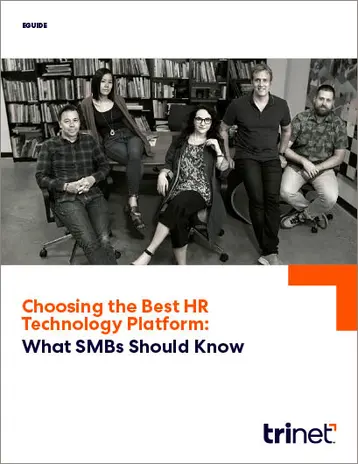
Human resource professionals are no strangers to change. Economic factors, generational changes, technology shifts, and other elements transform operating norms on a regular basis. One shift that has been picking up speed in recent years is the human capital management approach to what is traditionally called human resources.
It's enlightening to follow human capital management trends. We can learn how organizations are using them to push their success forward. We can think about ways to get ahead of the trends and gain a competitive advantage. In this article, we'll review HR trends and how they may affect your company's workplace.
What is human capital management (HCM)?
Until recently, employees had been viewed as a business expense. The HCM concept flips that and operates on the premise that employees are an asset.
HCM includes processes that have always been found under the HR umbrella, like onboarding, payroll processing, and administering benefits. The difference with HCM lies in the functions added to the list, like talent development, performance management, and employee engagement. For the former processes, HCM uses technology to streamline things and gain efficiency. That allows more time and attention for investing in employees through those latter functions.
1. Addressing the skills shortage
One of the most prevalent human resources trends involves finding ways to deal with the workforce skills shortage. A recent study by Manpower Group found that 75% of employers experience difficulty filling open roles.
With Baby Boomers retiring at an explosive pace, many traditional positions can't be filled by Millennials and Gen Z. This challenge is known as the "skills gap."
A few of the human capital management strategies that may help mitigate this issue are:
- Recruiting talent from a wider pool, consider including international workers or different geographic locations.
- Implement upskilling initiatives. Employers are adding learning and development opportunities for existing workers to gain new skills, so they are qualified for emerging roles in the organization.
- Using technology. Human resources experts are increasingly seeing the value of automation tools. Tech products like project management software, customer management platforms, and human resources software helps to decrease manual requirements and create efficiency with fewer employees. Another strategic HR development is the use of artificial intelligence and human resource management software to help accelerate recruiting and onboarding.
- Remote work options. As mentioned above, flexible work arrangements are highly-sought by employees. It can benefit employers, too, by opening up the geographic boundaries of hiring beyond a set ZIP Code, city, or county. With a larger candidate pool, companies may be more likely to find the talent they need.
2. Investing in leadership
Another crucial HR strategy fueled by an HCM approach is focusing on building leaders, not just managers.
Leaders play a vital role in planning and executing organizational success. Companies are setting up HCM processes to:
- Identify high-potential employees. Sophisticated performance management tools help to provide insight on leadership qualities in employees.
- Create targeted development opportunities. Nurturing leadership at all levels helps to ensure the company stays strong and viable. These opportunities can include workshops, mentors, and coaching. Human capital management systems are creating enhanced ways to deliver training that prepares leaders with the skills they need to push a business to the next level.
- Recruit external leaders. Despite efforts, every company leader may not be a current employee. Some of them might be former employees! Career transition support enables high-growth businesses to enhance their professional reputation by helping employees evaluate new opportunities and focus on their futures. When those employees do leave for new opportunities, they can be advocates who send fresh talent to their former employer. They also gain new skills and experience that they sometimes bring back to fill leadership roles with the former employer who invested in them.
3. Focusing on employee well-being
Focusing on the awareness of mental and physical health is one of the most impactful current and future HR trends. This trend is multi-faceted and may include the following actions:
- Providing employees with robust health benefits.
- Offering access to physical and mental health awareness resources.
- Flexible and or remote work options.
- Access to stress management, mindfulness programs, and counseling services.
- Regular team-building activities that encourage relationship building and social connections within the organization.
Companies are increasingly seeing that investing in their employees' well-being is a beneficial thing to do and a strategic imperative. It helps to attract and retain talent, drives performance, and increases engagement.
4. Putting people first, work arrangements second
Until recently, employers set work requirements. Inflexible work schedules dictated where employees may work and many other elements of the work week. People management, or People Ops, has helped change that, with the help of virtual solutions and tech advancements. Remote and hybrid work are much more common now.
This has been changing since the COVID pandemic, but current HR trends show that the hybrid model is becoming more prominent. It gives people the flexibility to work remotely some of the time while still affording the chance to colloborate with co-workers in a structured office. A study by AT&T says the hybrid model is expected to reach 81% of the workplace in 2024. Millennial work expectations, formed in part by the pandemic, place working remotely as one of the most important job benefits, sometimes even surpassing salary requirements.
In light of this trend, one of the most strategic HR solutions from a talent management standpoint is to offer plenty of flexibility in every role. A people-first approach (instead of rigid schedules) approach helps to increase productivity and employee engagement and reduce turnover.
5. Analytics
The last HCM trend deals with data. Human resources information management leverages data to help employers make more informed decisions.
HR tech companies are using advanced algorithms and machine learning to identify patterns and correlations within historical data. These tools help predict future workforce trends, challenges, and opportunities. HR tech trends in artificial intelligence are becoming a pivotal in helping to successfully manage an organization's recruiting, retention, training, and succession planning initiatives.
Strategic human resource management can also use analytics for studying employee behavior, preferences, and performance. This knowledge helps companies stay competitive and agile.
Stay on Top of HCM Trends with TriNet
The pressure of constant change is pushing businesses to reimagine strategies, lead distributed teams, create cultures of inclusion and try new methods. Many organizations have the ability to adapt, but lack the specialized expertise to develop strategic HR plans. TriNet’s experts can help.
Our consultants can help your leadership and organization toward your goals and untie your strategy to help achieve the desired results. With our powerful platform, attentive support, and wide array of services, we are your comprehensive human capital management solution. Reach out today for a no-obligation consultation.
This communication is for informational purposes only, is not legal, tax or accounting advice, and is not an offer to sell, buy or procure insurance.
This article may contain hyperlinks to websites operated by parties other than TriNet. Such hyperlinks are provided for reference only. TriNet does not control such web sites and is not responsible for their content. Inclusion of such hyperlinks on TriNet.com does not necessarily imply any endorsement of the material on such websites or association with their operators.






